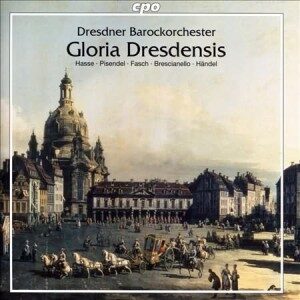Here’s a very pleasant, expertly played and recorded collection of works from the repertoire of the Dresden Court Chapel in the first half of the 18th century. According to the detailed and informative notes, this particular program of orchestral works–sinfonias, sonatas, and overture-suites–is drawn from manuscript sources “rediscovered around 1860” in a cabinet in the Catholic Court Chapel after many decades of virtual neglect. Although interest in the hundreds of manuscripts has in the last several years prompted some performances and recordings, much of the music, which was once worthy of one of Europe’s finest orchestras, is not well-known, nor are several of its composers, names such as Brescianello, Fasch, and Pisendel, except to specialists and the most avid fans of Baroque music.
And for those fans–and for newcomers alike–there is nothing not to appreciate and enjoy on this program, from Pisendel’s very Bach-like C minor Sonata (the two composers had met in Weimar and were familiar with each other’s music), to Fasch’s substantial overture-suite in F major, with its tinges of Handel but also unique touches like a flute/bassoon duet in the “Jardinier” movement and a charming little flute duet in the “Gavotte”. Caldara offers a brassy opening movement along with his own duet for bassoons and various solo-instrument highlights in his C major Sinfonia.
Hasse’s Sinfonia in D major (the introduction to his opera Demofoonte) charges immediately out of the gate with an aggressive Allegro featuring a dense-textured, dark-toned mix of winds and strings. Sammartini’s three-movement Sinfonia in A major also served as introductory music to an opera, Memet, believed to have received a performance in Vienna in 1732, its original string scoring later augmented with oboes and bassoon by Dresden concertmaster Pisendel. Handel’s overture to his Occasional Oratorio concludes the disc (again with additions by Pisendel of two “extra” movements and flutes).
As mentioned, the orchestral playing is very fine, with excellent contributions from the various soloists, and the sound, recorded in an ideal church acoustic–in Radeberg, outside Dresden–effectively captures the rich timbres and vibrant ensemble produced by the group’s Baroque instruments. Strongly recommended.
































